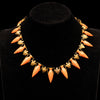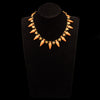Description
An antique so-called fringe necklace in gold with coral amphorae. From the era of the 'archaeological revival'.
Italy, circa 1870
Necklaces with gold fringes from the Hellenistic period and typical granulation of Etruscan work inspired jewelers for two decades from the 1860s. The center for this so-called 'archaeological revival' jewelry was Rome, where Castellani's workshop set the trend. Necklaces in this style were designed as chains or woven bands of gold supporting pendants in the shapes of amphorae, drops, shells, seeds, pomegranates, leaves and berries. Most of these chains feature eye and hook or S-shaped clasps and often bear a mark or signature of their maker.
'Fringe necklace' is the term used to define a neck ornament of hanging elements suspended from a string or chain with various shaped links; these drops can be graduated in size from the center to fit the contours of the base of the neck. The concept of stringing pendants to create a body adornment dates back to the origins of the chain itself, which dates back to at least 30,000 BC. However, the earliest and most impressive example of this type of necklace dates from the mid-3rd millennium BC. in Egypt, where it was known as the wesekh or wide collar. This consisted of several rows of cylindrical beads of stone or glazed composition, graduated in size and strung vertically in an open circular design between terminals of a semi-circular shape.
Necklaces with gold fringes from the Hellenistic period and typical granulation of Etruscan work inspired jewelers for two decades from the 1860s. The center for this so-called 'archaeological revival' jewelry was Rome, where Castellani's workshop set the trend. Necklaces in this style were designed as chains or woven bands of gold supporting pendants in the shapes of amphorae, drops, shells, seeds, pomegranates, leaves and berries. Most of these chains feature eye and hook or S-shaped clasps and often bear a mark or signature of their maker.
Details
Details
Maker·niet gesigneerdPeriod·Victorian (1837 - 1901)Material·yellow gold & coralWeight·38 gDimensions·length 46 cmRef number·7155















